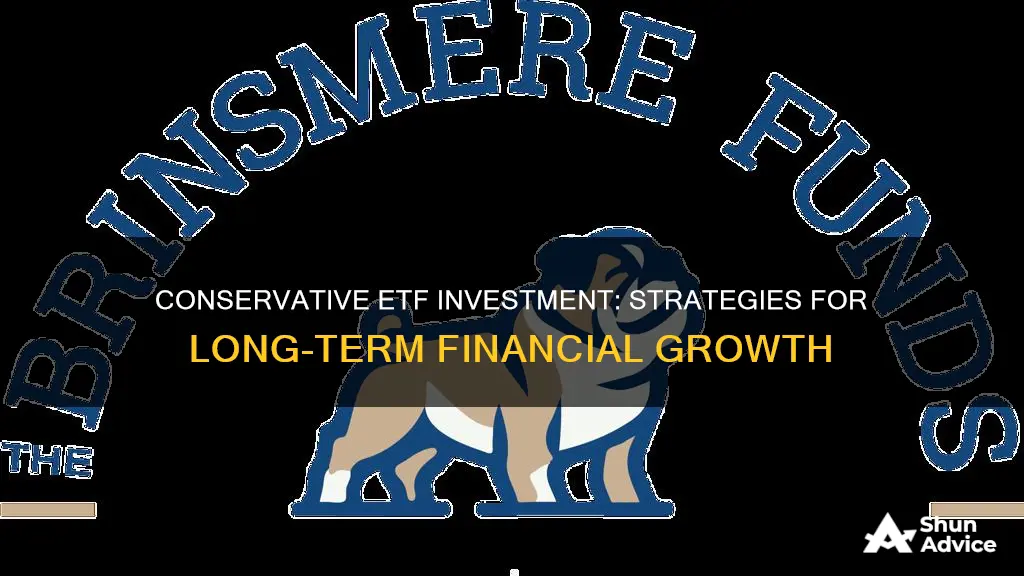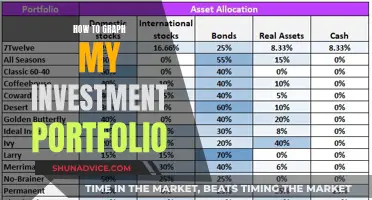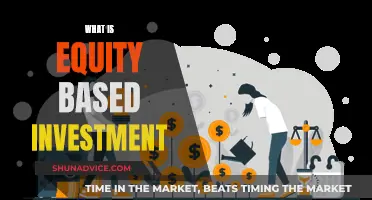
Conservative investing is a strategy that prioritises capital preservation over growth or market returns. This approach seeks to protect an investment portfolio's value by investing in lower-risk securities such as blue-chip stocks, fixed-income securities, money markets, and cash or cash equivalents.
Conservative investors typically have a low to moderate risk tolerance, and their portfolios consist of a larger proportion of low-risk, fixed-income investments and a smaller selection of high-quality stocks or funds. This strategy often involves investing in the safest short-term instruments, such as treasury bills and certificates of deposit.
While conservative investing may safeguard against inflation, it may not yield substantial returns over time when compared to more aggressive strategies. As investors approach retirement age, they are frequently advised to adopt this approach, regardless of their individual risk tolerance.
ETFs, or Exchange-Traded Funds, are an attractive option for conservative investors as they offer diversification, cost-effectiveness, and liquidity, making them ideal for those who favour a buy-and-hold approach. When selecting an ETF, factors such as the net expense ratio, diversification of holdings, potential dividend yield, and overall liquidity should be carefully considered.
| Characteristics | Values |
|---|---|
| Investment strategy | Prioritises preservation of capital over growth or market returns |
| Risk tolerance | Low to moderate |
| Portfolio composition | Larger proportion of low-risk, fixed-income investments and a smaller proportion of high-quality stocks or funds |
| Investment types | Treasury bills, certificates of deposit, large-cap or blue-chip equities, treasuries and other high-quality bonds, money markets, cash or cash equivalents |
| Returns | Lower than more aggressive strategies |
| Investment objective | Long-term capital growth, current income |
| Investment approach | Buy-and-hold |
| Investment factors | Net expense ratio, diversification of holdings, dividend yield, liquidity |
What You'll Learn

Low-cost funds
ETFs, or Exchange-Traded Funds, are a popular investment vehicle for conservative investors due to their unique combination of diversification, cost-effectiveness, and liquidity. When selecting an ETF, it is important to consider factors such as the net expense ratio, diversification of holdings, potential dividend yield, and overall liquidity.
IShares Core Conservative Allocation ETF
This ETF offers a simple and low-cost way to build a diversified portfolio based on conservative risk considerations. By harnessing the experience of BlackRock and the efficiency of iShares ETFs, investors can gain exposure to a broad mix of bonds and global stocks. The expense ratio for this ETF is 0.20%, with a net expense ratio of 0.15%.
Vanguard S&P 500 (NYSE: VOO)
The VOO ETF aims to mirror the S&P 500 Index, a widely followed benchmark for the US stock market. With a net expense ratio of just 0.03%, it offers a cost-effective and diversified way to invest in large US companies. As of 2023, the ETF had a dividend yield of 1.46% and a market capitalisation of $326.67 billion.
Utilities Select Sector SPDR Fund (NYSE: XLU)
The XLU ETF focuses on the utilities sector, which is known for its defensive and income-generating characteristics. The fund aims to match the performance of the Utilities Select Sector within the S&P 500 Index, which includes companies in electric utilities, multi-utilities, independent power producers, energy traders, and gas utilities. While the ETF has a higher net expense ratio of 0.10%, it tends to offer higher dividend yields than broader market ETFs, making it attractive for income-seeking investors.
SPDR Gold Shares (NYSE: GLD)
The GLD ETF tracks the price of gold, a precious metal widely considered a safe-haven asset. With a relatively high net expense ratio of 0.40%, this ETF does not offer dividends. However, its stability and long-term performance can make it a good choice for conservative investors looking to hedge against inflation, currency fluctuations, and market volatility.
Conservative investors should carefully consider their financial goals, risk tolerance, and investment time horizon when selecting low-cost funds. It is important to remember that while conservative investing can help protect capital, it may also result in lower returns compared to more aggressive investment strategies.
Understanding Private Equity: Primary Investment Basics
You may want to see also

Long-term, balanced portfolios
Conservative investing is a strategy that prioritises capital preservation over growth, seeking to protect a portfolio's value by investing in lower-risk securities. This approach often entails investing over half of a portfolio in debt securities and cash equivalents, such as bonds, money markets, and cash or cash equivalents, rather than equities or other riskier assets.
Conservative investors typically have a low to moderate risk tolerance. They tend to favour low-risk, fixed-income investments, with a smaller allocation to high-quality stocks or funds. This strategy is often adopted by older investors seeking to protect their financial assets without taking on significant risks.
When considering a conservative ETF investment for a long-term, balanced portfolio, here are some key factors to keep in mind:
Diversification
ETFs offer a unique combination of diversification, providing exposure to a basket of securities or assets. This diversification can help reduce the overall risk of your portfolio by spreading your investment across various assets, sectors, or regions.
Cost-Effectiveness
ETFs are generally known for their cost-effectiveness, with lower expense ratios compared to other investment options. This makes them an attractive choice for long-term investors, as the lower fees can compound to significant savings over time.
Liquidity
ETFs are highly liquid investments, allowing investors to buy and sell them on stock exchanges throughout the trading day. This liquidity provides flexibility and ease of access to your investments, which is essential for long-term portfolio management.
Dividend Yield
Some conservative ETFs offer dividend yields, providing a source of current income for investors. This can be an attractive feature, especially for those seeking regular cash flows from their investments.
Overall Risk Profile
When constructing a long-term, balanced portfolio, it's crucial to consider the overall risk profile of the ETF. Conservative ETFs typically have a lower risk profile, investing in stable, well-established companies or assets. This lower risk often comes with the trade-off of limited growth potential.
Specific ETF Options
- Vanguard S&P 500 (NYSE: VOO): This ETF aims to mirror the S&P 500 Index, providing diversified exposure to large US companies. It has a low expense ratio of 0.03% and offers a dividend yield of 1.46%.
- Utilities Select Sector SPDR Fund (NYSE: XLU): XLU focuses on the utilities sector, known for its defensive and income-generating characteristics. It aims to match the performance of the Utilities Select Sector within the S&P 500 Index. The ETF has a dividend yield of 3.22% but a higher expense ratio of 0.10%.
- IShares Core Conservative Allocation ETF: This ETF seeks to provide a diversified portfolio with conservative risk considerations, offering exposure to a broad mix of bonds and global stocks. It has a low expense ratio of 0.15%.
- SPDR Gold Shares (NYSE: GLD): GLD is a conservative ETF that tracks the price of gold, a precious metal widely considered a safe-haven asset. While it does not offer dividends, it provides stability and a hedge against inflation and market volatility. However, it has a relatively high expense ratio of 0.40%.
Remember, when constructing a long-term, balanced portfolio, it's important to consider your investment goals, time horizon, and risk tolerance. Diversification and a careful assessment of risk and return potential are key to successful long-term investing.
Private Equity Investments: Revocable Trust Pros and Cons
You may want to see also

Risk mitigation
Diversification
Diversification is a fundamental risk-mitigation strategy for any investment portfolio, and it applies to conservative ETF investing as well. By spreading your investments across various asset classes, sectors, and geographic regions, you reduce the impact of any single negative event. Diversification can be achieved by investing in broad-based ETFs that track a diverse range of securities or by constructing a portfolio of multiple ETFs with different focuses.
Focus on Lower-Risk Securities
Conservative investing typically involves a larger proportion of lower-risk securities such as government bonds, investment-grade corporate bonds, and blue-chip stocks. These types of investments are considered more stable and less volatile than high-risk growth stocks or speculative investments. Lower-risk securities may provide lower returns, but they help preserve capital and reduce the overall risk of the portfolio.
Emphasize Capital Preservation
Conservative investors often prioritize capital preservation over aggressive growth. This means avoiding excessive risk and focusing on maintaining the value of your investments. Short-term, safe instruments such as treasury bills, certificates of deposit, and money market funds can be used to preserve capital. These investments provide a stable foundation for your portfolio, even if they offer lower returns.
Consider Defensive Strategies
Defensive investing strategies aim to protect your portfolio during market downturns or economic recessions. By adopting a defensive strategy, you can shift your investments towards more stable and defensive sectors, such as utilities or consumer staples, which tend to be less volatile and provide a hedge against market declines. Defensive strategies are particularly useful when you anticipate negative market movements but still want to maintain some level of growth potential.
Monitor and Rebalance Your Portfolio
Regularly monitoring and rebalancing your ETF portfolio is essential for risk management. Over time, the performance of different investments within your portfolio can cause it to deviate from your desired asset allocation. By periodically rebalancing, you can return your portfolio to its intended allocation and ensure that you maintain the appropriate level of risk.
Conservative ETF investing is a strategy that prioritizes capital preservation and lower risk. By incorporating these risk-mitigation techniques, you can build a conservative ETF portfolio that aligns with your investment goals and risk tolerance.
India's Space Exploration: Worth the Investment?
You may want to see also

Capital growth
When considering a conservative ETF investment, it is important to understand the investment goals and risk tolerance. Conservative investing typically prioritises capital preservation and stable income over aggressive growth strategies. While conservative approaches may offer limited growth potential, they can help protect against significant losses. Here are some key considerations for capital growth within a conservative ETF investment strategy:
Diversification
Diversification is a crucial aspect of conservative investing. By investing in a broad range of asset classes, sectors, and securities, investors can reduce the overall risk of their portfolio. Diversification ensures that the potential losses in one area are mitigated by gains or stability in other areas. ETFs, by design, offer built-in diversification, as they typically hold a basket of securities. For example, the iShares Core Conservative Allocation ETF offers exposure to a mix of bonds and global stocks.
Low-Cost Structure
ETFs are known for their cost-effectiveness, which is an important consideration for conservative investors. The expense ratio, which represents the ongoing costs of managing the fund, should be considered when selecting an ETF. Lower expense ratios mean that a larger portion of the returns stays with the investor. The iShares Core Conservative Allocation ETF, for instance, has a low net expense ratio of 0.15%.
Long-Term Perspective
Conservative investing often involves a long-term perspective, focusing on wealth preservation and steady income rather than short-term gains. This approach aligns with the buy-and-hold strategy commonly associated with ETFs. By holding investments for the long term, conservative investors can benefit from compound interest and long-term capital appreciation, potentially generating significant returns over time.
Risk Management
Risk management is a key focus of conservative investing. While all investments carry some degree of risk, conservative investors seek to minimise potential losses. This involves careful asset allocation, favouring lower-risk securities such as high-quality bonds, blue-chip stocks, and cash or cash equivalents. Additionally, conservative investors may adopt a defensive strategy by shifting towards safer assets when anticipating market downturns.
Capital Appreciation Potential
While conservative investing prioritises capital preservation, it is still possible to achieve capital growth. By investing in a diversified portfolio of ETFs with a long-term perspective, investors can benefit from the compound effects of steady returns and reduced fees. Additionally, certain sectors, such as utilities, are known for their defensive characteristics and income-generating potential, offering the possibility of modest growth while mitigating downside risk.
In summary, a conservative ETF investment strategy focused on capital growth involves careful asset allocation, a long-term perspective, and a strong emphasis on risk management. While returns may be more modest compared to aggressive strategies, conservative investing seeks to balance growth potential with the preservation of capital and stable income.
Public Equity Investment: How to Invest in Stocks
You may want to see also

Diversification
Conservative investors typically seek to preserve capital and reduce risk, and diversification is a powerful tool to achieve these goals. Diversification within an ETF can be achieved by investing in a range of asset classes, sectors, and geographic regions. For example, a conservative ETF may invest in a mix of stocks and bonds, providing exposure to different industries and markets. This diversification helps to spread risk and reduce the impact of any single investment on the overall portfolio.
ETFs also allow investors to access a diversified portfolio of securities with a relatively small amount of capital. This is because ETFs trade on an exchange like a stock, and investors can purchase a single share of an ETF, which represents a fractional ownership in a diversified basket of securities. This makes it easier for conservative investors to access a well-diversified portfolio without needing a large amount of capital.
Additionally, some ETFs are specifically designed with a conservative investment strategy in mind. These ETFs may have a broader diversification strategy, investing in multiple asset classes and focusing on capital preservation and income generation. For example, the iShares Core Conservative Allocation ETF seeks to provide a diversified portfolio of bonds and global stocks, offering conservative investors a simple way to build a core portfolio with a single low-cost fund.
Conservative investors can also achieve diversification by investing in multiple conservative ETFs with different strategies and asset allocations. This allows investors to gain exposure to a wider range of securities and further reduce the impact of individual investments on their portfolio's performance.
Overall, diversification is a critical tool for conservative investors seeking to preserve capital and manage risk. ETFs provide an excellent vehicle for achieving diversification, offering access to a variety of securities and asset classes through a single investment vehicle. Conservative investors can utilise the benefits of ETFs to build well-diversified portfolios that align with their investment goals and risk tolerance.
Understanding the Makeup of a Modern Investment Portfolio
You may want to see also
Frequently asked questions
Conservative ETF investing takes a cautious approach to investing to avoid negative returns. This typically involves investing in lower-risk securities such as blue-chip stocks, fixed-income securities, money market instruments, and cash or cash equivalents.
Some examples of conservative ETFs include the iShares Core Conservative Allocation ETF, Vanguard S&P 500 (NYSE: VOO), Utilities Select Sector SPDR Fund (NYSE: XLU), and SPDR Gold Shares (NYSE: GLD).
A conservative ETF investment strategy prioritizes capital preservation and aims to protect an investment portfolio's value. This approach may be suitable for investors with a low to moderate risk tolerance, those seeking current income, or those who believe asset prices will decline.
Conservative ETF investing may result in limited growth potential and lower returns compared to more aggressive investment strategies. It may not be suitable for investors seeking higher returns or those with a higher risk tolerance.







